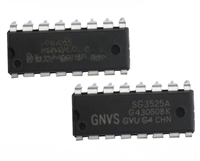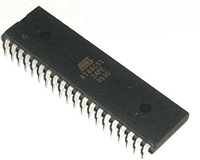AD9525
Data Sheet
LVPECL CLOCK DISTRIBUTION
SYNC_OUT DISTRIBUTION
The LVPECL outputs (because they are open emitter) require
a dc termination to bias the output transistors. The simplified
equivalent circuit in Figure 22 shows the LVPECL output stage.
The SYNC_OUT driver of the AD9525 can be configured as
CMOS drivers. When selected for use as CMOS drivers, each
output becomes a pair of CMOS outputs, each of which can be
individually turned on or off and set as inverting or noninverting.
Be sure to note the skew difference of using CMOS mode vs.
LVPECL mode.
In most applications, a LVPECL far-end Thevenin termination
(see Figure 35) or Y-termination (see Figure 36) is
recommended. In both cases, VS of the receiving buffer should
match VS_DRV (VS_DRV = VDD3). If it does not match, ac
coupling is recommended (see Figure 37).
When single-ended CMOS clocking is used, refer to the guidelines
presented in the following paragraphs.
VS_DRV
Point-to-point connections should be designed such that each
driver has only one receiver, if possible. Connecting outputs in
this manner allows for simple termination schemes and minimizes
ringing due to possible mismatched impedances on the output
trace. Series termination at the source is generally required to
provide transmission line matching and/or to reduce current
transients at the driver.
VS_DRV
V
S
127Ω
127Ω
50Ω
SINGLE-ENDED
(NOT COUPLED)
LVPECL
LVPECL
50Ω
83Ω
83Ω
The value of the resistor is dependent on the board design and
timing requirements (typically 10 Ω to 100 Ω is used). CMOS
outputs are also limited in terms of the capacitive load or trace
length that they can drive. Typically, trace lengths less than 3 inches
are recommended to preserve signal rise/fall times and signal
integrity.
Figure 35. DC-Coupled 3.3 V LVPECL Far-End Thevenin Termination
VS_DRV
V
= VS_DRV
LVPECL
S
Z
Z
= 50Ω
= 50Ω
0
50Ω
50Ω
50Ω
LVPECL
60.4Ω
(1.0 INCH)
10Ω
CMOS
CMOS
0
MICROSTRIP
Figure 36. DC-Coupled 3.3 V LVPECL Y-Termination
Figure 38. Series Termination of CMOS Output
Termination at the far end of the PCB trace is a second option.
The SYNC_OUT CMOS output of the AD9525 does not supply
enough current to provide a full voltage swing with a low
impedance resistive, far-end termination, as shown in Figure 39.
The far-end termination network should match the PCB trace
impedance and provide the desired switching point. The reduced
signal swing may still meet receiver input requirements in some
applications. This can be useful when driving long trace lengths
on less critical nets.
VS_DRV
V
S
0.1nF
100Ω DIFFERENTIAL
(COUPLED)
100Ω
LVPECL
LVPECL
0.1nF
TRANSMISSION LINE
200Ω
200Ω
Figure 37. AC-Coupled LVPECL with Parallel Transmission Line
V
LVPECL Y-termination is an elegant termination scheme that
uses the fewest components and offers both odd- and even-mode
impedance matching. Even-mode impedance matching is an
important consideration for closely coupled transmission lines
at high frequencies. Its main drawback is that it offers limited
flexibility for varying the drive strength of the emitter-follower
LVPECL driver. This can be an important consideration when
driving long trace lengths but is usually not an issue.
S
100Ω
50Ω
10Ω
CMOS
CMOS
100Ω
Figure 39. CMOS Output with Far-End Termination
Because of the limitations of single-ended CMOS clocking,
consider using differential outputs when driving high speed
signals over long traces. The AD9525 offers SYNC_OUT
LVPECL outputs that are better suited for driving long traces
where the inherent noise immunity of differential signaling
provides superior performance for clocking converters.
Thevenin-equivalent termination uses a resistor network to
provide 50 Ω termination to a dc voltage that is below VOL of
the LVPECL driver. In this case, VS_DRV on the AD9525
should equal VS of the receiving buffer. Although the resistor
combination shown results in a dc bias point of VS_DRV − 2 V,
the actual common-mode voltage is VS_DRV − 1.3 V because
there is additional current flowing from the AD9525 LVPECL
driver through the pull-down resistor.
Rev. 0 | Page 46 of 48






 SG3525资料手册详解:SG3525参数分析、引脚说明、应用介绍
SG3525资料手册详解:SG3525参数分析、引脚说明、应用介绍

 AT89C51单片机资料手册详细解析及应用示例
AT89C51单片机资料手册详细解析及应用示例

 CP2102资料手册解读:CP2102引脚说明、关键参数分析
CP2102资料手册解读:CP2102引脚说明、关键参数分析

 资料手册解读:UC3842参数和管脚说明
资料手册解读:UC3842参数和管脚说明
